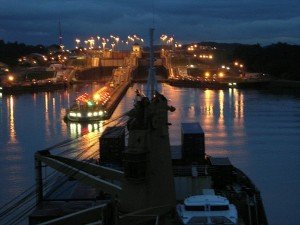Once sailing ships battled their way through the seas off Cape Horn. Now container vessels make their way through the Panama canal. The purpose is the same: to link the markets of the Pacific world with those of the Atlantic, trading the raw commodities and consumer goods that power the global economy. Like the Suez canal, the Panama canal is a vital pinch point and an immensely profitable strategic asset. Last week oil traders scrambled to plan alternative supply routes in the event that the Egyptian crisis closed the Suez canal.
Less attention has been paid to the dramas being played out in central and South America, but they could have greater consequences. The building of the Panama canal, running 50 miles between two oceans, was an engineering triumph, completed by American engineers after decades of struggle through thick forest and swamps. By modern standards, though, it is small, crowded and expensive: carrying some 300m tonnes of shipping a year against the planned 80m, or about 5% of all world trade. The largest modern cargo vessels cannot fit in it and Panama’s neighbours look jealously at the revenues it produces, an average of $50,000 per ship. As China’s economy grows –this week it overtook Japan’s and is the second-largest user of the canal – so does the pressure to find alternatives.
One scheme – now under way in Panama, despite its controversial environmental consequences – will widen the lock gates at the canal entrances, to allow bigger ships to use it. Other vessels dock on the west coast of the United States and unload their containers directly on to giant trains that carry them to American consumers in the east. This week attention also turned to a Colombian-Chinese plan to build a similar rail link across the South American country, bypassing the Panama canal to the north. This so-called “dry canal” would make it easier for Colombia to export coal to China and will be taken, by those who see China as a threat, as evidence of the country’s expansionism – just as Britain, France and then America found themselves battling over the Suez and Panama routes in the 19th century.
Meanwhile, to Panama’s north, some suspect Iranian troublemaking in a plan to build a canal along the Nicaraguan-Costa Rican border – a route considered a century ago. Nicaraguan vessels began dredging the Caribbean end of the San Juan River, intruding into Costa Rican territory. Costa Rica has protested to the international court of justice in the Hague, which is now considering its judgement. Building another canal here would cost billions: an impossible dream. But the imperial battle over trade routes is far from over.